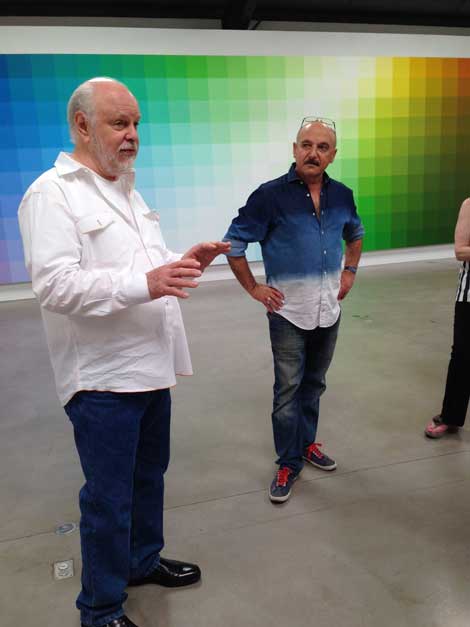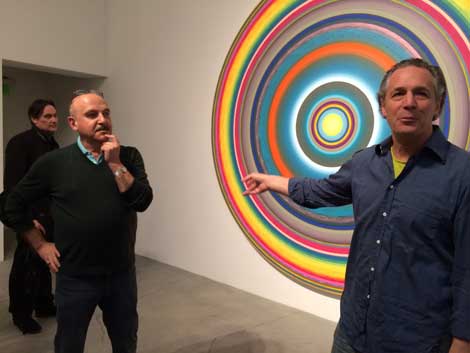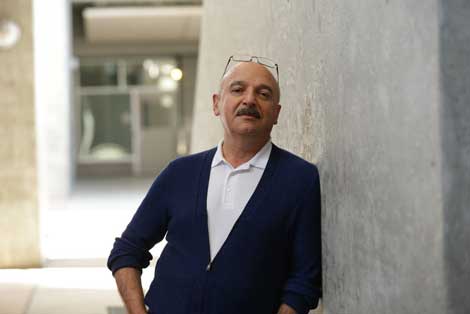One rainy afternoon, Edward Goldman’s parents popped into the winter palace of the Russian Czars, known today as the state Hermitage Museum of Russia, with their young son. The next time it rained, Edward asked to go again to the “place where naked men and women are standing.”
Edward Goldman became an expert in Grecian and Roman antiquities, with a Master’s Degree in history and museum studies from what is now St. Petersburg State University; by the time he landed at LAX in 1978 at the age of 30, he had already been working at The Hermitage for eight years. He emigrated with his family, dragging 2,000 books on his way to New York for political asylum—but he felt an immediate “chemical reaction” to LA and has been a vocal supporter ever since.
In 1988, Goldman became a voice for the LA art world with his weekly art commentary program “Art Talk” ON Santa Monica College’S POPULAR radio station KCRW. At first, listeners complained that they could not understand his commentary because of his thick accent, but the radio station stood by him, saying that there are many Russian immigrants in Los Angeles. Edward Goldman has been talking about art on the radio (and now via podcast online) weekly for 25 years (oddly enough, his accent is still quite thick). “God forbid people live without their cultural compass for one week,” he said in a new york times profile.
Goldman runs art-collecting seminars called “The Fine Art of Art Collecting,” and is an adviser for private and corporate collectors. In January, he did a TEDX talk at Santa Monica’s Barker Hangar, discussing his passionate attraction to both Los Angeles and art produced here. “Whenever you look at great art—in museums, in private collections or in the studio of the artist—you’re looking at the artist directly,” he said. “Real art allows us to touch the soul of generations that existed thousands of years ago.”
Edward Goldman and I talked by phone right after Easter, a day he had spent largely in bed recovering from an exhausting and exhilarating tour with his “art gypsies” of the Getty show “Heaven and Earth,” (which reminded him of the icons of his childhood) and to a Neutra house on Pacific Coast Highway that he describes as “the spirit of California mid-century architecture at its absolute best.”
Artillery: You call yourself an art critic, yet you rarely seem critical of art. In your podcast on KCRW, in your TEDX talk, you seem passionate, curious, insightful and full of love for it.
Edward Goldman: I’m an art commentator, if you wish. Being a critic doesn’t necessarily mean being critical and negative. I’m trying to find something to stir up my emotions, make me think, to connect me with something and to share with people—middle-of-the-road exhibitions, what’s the point? I want to find something that I can share with my audience like I would call my friends: you have to see this exhibition, it’s so important, so intriguing! Those kinds of exhibitions are few. Mediocre exhibitions, I see them, but I don’t bother to talk about them.
I can be very critical, very negative about things that other people are unwilling to talk about, such as a recent re-imagining of the campus of the Los Angeles County Museum of Art. I also did an Art Talk a few weeks ago—“Rembrandt is In and Putin is Out”—about the fact that President Obama was photographed inside the Rijksmuseum in Amsterdam, standing in front of the most famous painting in Holland, Rembrandt’s Night Watch. It’s an amazing photograph, and I was proud to see him, but why do I never remember seeing the President of the United States in any of the museums in the United States? We would be living in a different country if our presidents discovered a passion for art while they were still in the White House.
I heard you called an artist out at his opening for not taking enough risks in his work.
This is an issue that happens with artists who reach a level of success—not only aesthetic, artistic success but also commercial success: you know, there is quite a difference between the two. You get the respect of your colleagues, and museum people and the art scene, and if on top of that you get commercial success, people are buying and fighting for your works, and everybody loves your works, it’s very difficult to step away from that—[being] adored by the crowd.
People are applauding you as if you were an actor, singer, dancer and it gives you another $100,000 every year. When we are young and we are taking risks, if we fall on our face, very few people notice. But when you are on a stage with lights on you, when you take a risk and don’t succeed—after you’ve been successful for the last five or 10 years—it’s painful. Once upon a time, artists were making works just to express themselves. Now when you’re a commercial success, half a dozen galleries are waiting for you to deliver. You’re spending a lot of psychic and aesthetic energy fulfilling business obligations. To take a risk, you need to have free time, time to think, take a break.
What do you say to artists to encourage them to take a break?
I don’t have advice; only if you want to reconnect to the angels and saints in your soul, and have another new, serious chapter in your art, you have to think less about commercial success, more about something like eternity—how it’s going to be perceived 10, 15, 30 years from now. Matisse continued, even in spite of being crippled and unable to hold a brush in his hand, to do paper cuts with a scissors, collages. But that is the genius of Matisse and the strength, to go beyond, to grow more.
Great artists are by nature explorers. Imagine an explorer who goes on the same tour again and again. Here is the whole point. And we, as a people who love art, shouldn’t be doing the same things that we already love and enjoy. We have to be courageous and smart and hungry for new experience, new adventure.
That’s a brilliant segue to talk about your art tours. You call them “The Fine Art of Art Collecting” classes. How is collecting a fine art?
You have to find something that particularly appeals to and defines who you are and what you stand for. Nothing wrong about falling in love with Impressionism or with Sam Francis or David Hockney artworks—all wonderful things—but it’s familiar, it’s something you know, and you are preconditioned to like it. Can you find something that your friends all say, “Oh, I never heard about that.” Or your friends say, “Why do you like it? What makes you like it?” To find some up-and-coming artist that you can discover. There are collectors like the Vogels—who not only discovered a number of future famous artists in the ’60s, when these artists couldn’t get arrested on the street for their art, then helped to shape the career of these artists; they started to do it before anyone was collecting. They made themselves connoisseurs of the New York art scene of the ’60s and ’70s. And they’ve done it not to invest money—it’s ridiculous investing money in art no one knows about—they invested their soul.
When people ask me, “Can you advise us how to invest?” I say yes, invest your soul. Anytime any dealer or any artist tells you, talking about contemporary art, “This is a good investment of your money,” run in the opposite direction. As they say famously or infamously in Hollywood, “No one knows nothing.”
I’ve seen people buy art because of their passion, and strangely enough, 10, 20 years later discover that this artist becomes a mega-celebrity, and all of a sudden the art becomes an investment—but it was never meant to be an investment.
Can you imagine if you invested yourself in your friendship because someday it will pay off when these people become celebrities? It’s bullshit. It’s not the way to build a personal relationship with people, or devote your precious, limited time on this earth, just hopefully….No: if they’re good right now, they’re good right now.
The most interesting thing about your “art gypsy caravan” itineraries for me is that you’re going to see private collections. How do you get this kind of access?
We are going to private collections, we are going to studios of artists, we are going to museums. For example, we had a fantastic tour of the “Heaven and Earth” exhibition with the Getty Villa antiquities curator, Mary Hart. It’s not that they give us a tour; I know these people for years. I never want it to be a lecture; it’s a conversation. I will often ask private collectors, “I want you to share with us a precious lesson. What was the silliest thing you’ve ever done as a collector?” As an artist, as a human being, if you’re not learning from your mistakes, you are not smart. The insights are priceless: when you did something silly and you learned from that. Sometimes a collector says the silliest thing is what they acquired, but most of the time it’s “I didn’t buy,” and they will tell you some of the artworks they were exposed to and didn’t buy, because they didn’t have the $50 or $75 to buy a Warhol painting.
What are some of the LA collections you’ve seen?
Cleve and Mandy Einstein. For a number of years, Cleve was President of the Board of Trustees of LA MOCA. They’re remarkable collectors, whose collection is all museum quality. They have curatorial talent in presenting and combining the artworks, a sophistication not too many museum curators can compete with. We’ve been to the photography collection of the person who is known as “a caterer to the stars,” Kai Loebach. He is wonderfully adventurous. Other very smart and adventurous LA–based collectors whom I visited with my art collecting class are Eileen Harris Norton, contemporary art with an emphasis on African American artists; Michael Wilson, the producer of James Bond movies, with the biggest private collection of photography in the world (22,000 photographs and counting); and Michael Ovitz, the founder of Creative Artists Agency, with a collection of high-end modern and contemporary art.
When you tour those collections, the collectors are telling you stories about them?
Absolutely. I want to ask them, what made them collect? How collecting changed their life, what kind of impact it has on their soul?
First of all, being a serious collector gives extraordinary access. Behind the scenes: not only in New York City, in your country, but wherever you’re traveling, all of a sudden you are a member of the “art gang.” You’re entering a new country, a new city? “Oh, you have to call my friends.” The door is open for you: you’re meeting museum people, artists, collectors. Based on my personal experience as a member of the Los Angeles art community, everyone wants you; you’re like a member of the family, which is big and small at the same time. It’s a fantastic privilege to be a member of this international community of art lovers. You cannot buy it; you can only earn it by the years of your passionate searching for art—learning about art, learning about yourself.
And what could be more joyful than being connected through your passion?
I think it is the best therapy one can imagine.
OK, tell me. You’ve been looking at art in LA for 25 years…
More. I’ve lived in Los Angeles for 35 years.
What do you collect for yourself?
I brought some artworks from Russia. I don’t have an empty square inch on my walls. But it’s not so much active; it’s more kind of passive collecting. Such things are a reminder of so many wonderful artists in Russia and here in Los Angeles. When you’re collecting, you’re actively acquiring, but in my case, it’s mostly gifts given by artists.
So your collection is all about relationships.
Yes, yes!
I read in your blog that you saw the Mike Kelley show in Paris. I saw it in Queens, at PS.1, and now it’s in LA.
Here in Los Angeles it has so much more room and air to breathe. In Paris, this exhibition gave me the distinct feeling that I cannot only see, I can hear this artist crying for help—even unbeknownst to him. First of all, it’s impossible to see this exhibition without being aware that he committed suicide. I couldn’t help it—in Paris, the work that they chose and how they showed it just reminded me the price that artists pay for their work, exposing themselves to the world, exposing their strengths and weaknesses, their perfection and imperfection.
There are very few things we can describe, talking about Mike Kelley’s art, as beautiful; many of his works are profound and disturbing. When you look at the great Rembrandt paintings of the Crucifixion, they are disturbing, but they also give you a sense of peace, balancing on the philosophical nature of his works. With Mike Kelley, you see the work of an extremely talented and original artist who is overwhelmed by what he sees in the world and what he experiences himself. It was interesting for me to realize that a year before Mike Kelley committed suicide, another artist, Alexander McQueen, also committed suicide—in both cases, a few months before a major retrospective opened in a major museum. I’ve heard from so many artists this kind of mid-career retrospective is a huge weight on their soul. To see everything they’ve done in the last 20 or 30 years, seeing all the things simultaneously, it’s so unusual and strange: you forgot about those pieces. Of course, some of the works you’ve done cost you a lot of turmoil. I asked one Los Angeles artist and he said, “You know what, Edward? When I’m working on the artwork, I fought with that. I won the battle and I never want to see the work again.” It’s almost like coming back 20 or 30 years later to your high school reunion: it’s so strange, so unsettling. I personally have done it once, and I won’t do it again.
How can the transmutation of Mike Kelley’s pain into art save the rest of us?
It can remind us that life definitely is not perfect. And give us tremendous respect for the artists who are using all the imperfections, pain, all the shit that happens to all of us. And the difference between us mere mortals and the artists—especially good artists, especially great artists—is an amazing ability and talent to transform the shit into manure they put into their art, into their garden. Like a good gardener knows, no one wants to step in the shit. “Eh!” But if you are a good gardener, you take this horse manure and you put it purposefully into the soil of your garden, and beautiful roses will grow out. So great artists have the God- and Muses-given talent to transform the imperfection, pain, shit of life into the great work of art. Might not necessarily be beautiful and peaceful, but they steal our soul.





![Edw-Goldman_image[1]](https://artillerymag.com/wp-content/uploads/2014/07/Edw-Goldman_image1.jpg)
















0 Comments